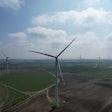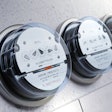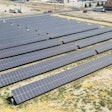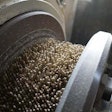Energy auditing may sound like an intimidating process, but following the guidelines provided by the EPA's Energy Star program makes it easy to decrease energy consumption and begin reaping the benefits of energy efficiency.
In today's tough economy, a main objective for many companies has become to decrease operating costs without decreasing production or compromising the quality of their product. With several fixed expenses, such as freight rates, the cost of raw materials and payroll, it may seem like cutting costs anywhere is out of reach.
Utility costs, however, are one of the largest variable operating costs, and energy management has recently become a popular way for companies to decrease overhead. There is a wealth of information, tools, resources and government programs available to the grain industry to help them identify what can be done to achieve greater energy efficiency.
In some cases, simply replacing old motors and bearings can make a huge difference in the utility bill. Other pieces of equipment such as conveyors, pellet mills and grinders can be energy hogs if they are outdated or not properly maintained. But an effective energy management strategy doesn't rely solely on a string of projects. It requires dedication from all levels of personnel, gathering and analyzing data, and checking progress regularly to stay on task.
Planning an energy management process
An energy management process is a combination of initiatives and actions taken to decrease energy consumption. The EPA's Energy Star program has outlined a series of steps to guide companies through the process. The first step, "make a commitment," is more mental than results-oriented, according to Jaron Vande Hoef, senior project engineer of Interstates, Sioux Center, IA. He says that in the beginning stages of implementing an energy management plan, it's essential for upper management to create a culture of energy awareness.
"Some companies never reap the potential gains from an energy reduction project because they didn't make energy awareness and management a part of their culture," he says. "Top levels of management must create an atmosphere of energy consciousness, so when they announce initiatives and projects to improve efficiency, it will make sense because it is consistent with the company's culture."
The next step is to "assess performance." This involves gathering and analyzing the past five years or so of utility bills to look for trends. This step serves as the starting point from which to measure progress and aids in formulating future energy consumption goals.
The breakdown of the charges is the most important factor to look at for this portion of the energy audit. Vande Hoef says usage fees should be around 60% to 70%, while 20% to 40% should be the demand fee (the amount the utility company charges for your peak usage in the past month). The remainder of the bill will consist of additional fees and penalties. If any of the percentages are far from what's expected, that's something to further investigate.
After that, search for any inconsistencies from month to month to identify which times of year the facility reaches its peak energy use.
If there are multiple facilities within the company, compare the bills for each to reveal locations that need improvement, and focus resources on the facilities that truly need it.
Based on the information gathered in the audit, a company can begin outlining goals and defining benchmarks. Goals can be expressed as a specific quantity decrease in energy use, such as a 10% reduction, or as a threshold requirement, the minimum acceptable level of performance. Assigning a date or time frame for achievement is also recommended by the EPA, such as a 25% reduction in total energy use from 1999 levels by 2010, or 20% improvement in energy performance within five years.
The next four steps, "create action plan," "implement action plan," "evaluate progress" and "recognize achievements," should be conducted and revised on a continual basis. The goals remain the same over a period of time, or until they are reached, but the action plan may change after evaluating progress.
Energy culprits
Not every facility will require the same projects to achieve energy efficiency. It will depend mostly on the specific equipment used in the facility, but one thing is certain across the board: Old motors are major energy culprits. Also, motors that are too large, are improperly maintained, or run 24/7 consume significant, and unnecessary, amounts of energy.
Vande Hoef says most motors more than 10 years old are inefficient by today's standards. Upgrading all motors in the facility may seem like an overwhelming expense, but the cost of the upgrade could quickly pay for itself. The high efficiency motors available today will deliver an immediate efficiency boost of 2% to 5%, which delivers directly to the bottom line.
"The initial purchase of a motor is only 2% of its lifetime cost," says Vande Hoef. "The energy consumed throughout its life makes up the remaining 98%."
Sometimes an entirely new motor isn't the only option, however. Adding a variable-speed drive to motors that simply have an on/off control will decrease energy consumption. This allows the facility to conserve energy when the equipment isn't running at full capacity. Michael Gurney, executive director of Concept Systems, Inc., Albany, OR, explains the benefits of a variable-speed drive.
"Many operations utilize across the line starters when instead, using a variable-speed drive system would deliver the power needed exactly when it's needed, which not only saves energy, but also adds life to the conveying equipment," Gurney adds. "With fans, variable-speed drives are much more energy-efficient and reduce the need for damper control by delivering the proper amount of power as needed. In general, systems which implement variable-speed control and better sequencing technology will deliver immediate benefits for these functions."
Other common pitfalls grain handlers face is not having the right sized motors for the specific tasks.
"People think they need the biggest motor they can get so they always have enough power behind their equipment, but this wastes huge amounts of energy," says Scholtens. "Always use the motor size specified by the equipment manufacturer to achieve maximum energy efficiency."
Properly maintaining equipment also helps increase energy efficiency. OJ Utter, president, Utter Precision Inc., Utica, NE, recommends facilities use a predictive maintenance plan, rather than waiting to fix problems when they arise.
"Preventive maintenance can translate to energy savings because it detects issues that contribute to energy inefficiency, such as a misalignment or a fan imbalance," says Utter. "These problems cause the motor to work harder and increase the amperage used."
The time of day is another factor to consider when trying to reduce energy costs. Many utility companies charge more for power during peak hours, such as 7 a.m. to 5 p.m. Gurney and Scholtens both heartily recommend conducting energy audits on a regular basis to assess usage patterns and to determine if efficiencies can be captured via operating during off peak-demand hours.
"It's better to stagger the usage of equipment throughout the day," says Scholtens. "It's going to be dependent on the mill and the utility companies, but sometimes it's most efficient to run loads overnight."
Jon Wheeler, support services department manager, Interstates, says that while common sense may tell you to turn off equipment if it's not being used, it is not always the best idea. Because of the sheer power it takes to start things up, large pieces of equipment should not be turned on and off several times throughout the day.
"There's a fair amount of debate over whether or not to leave equipment running so you don't get that high initial power intake," says Wheeler. "My recommendation is that if you stop a load for only 10 or 20 minutes during the day, you should leave it on. However, if you're going to be running something for only eight hours in a 24-hour period, leave it on while in use and then turn it off the rest of the day.
"That's why automation can be a big help. You can set idle times, so if a piece of equipment isn't being used for the time you've set, the automation program will simply shut off the equipment once it reaches that idle time," Wheeler concludes.
Production efficiency = energy savings
It's no secret that automated systems can drive efficiencies in production, information and data management, and material handling functions. But the benefits these systems deliver in the overall operation of a facility may overshadow a significant benefit automation delivers relative to energy savings.
Although a relative newcomer to designing and implementing systems specific to agriculture, Concept Systems has a long history in designing energy-efficient and productive automated systems solutions to a variety of industries including the mining, aerospace and energy production industries. Those industries and the grain industries all share one common goal: Boost productivity while reducing operating costs.
Gurney feels capturing energy savings through more efficient use of automation comes down to a simple matter of communication between the facility and the operator.
"Before someone makes that initial decision to introduce automated systems into their facility they really need to take a close look at what specific needs this automation is supposed to meet," Gurney says. "By taking a close look at how your facility operates and what primary tasks need to be done, you can reveal what areas would benefit most from automation.
"The facility provides the operator countless data points which tell the story of operational efficiency, collecting and organizing that data in a meaningful way will typically lead you to the areas which require attention."
Using heat to harness energy efficiency
Fully automating operations may be too large a step for some facilities, but there are other tools facility managers can take advantage of to improve energy efficiency, such as infrared imaging.
Infrared imaging was originally used by the military in the 1960s to detect heat seeking missiles, but today infrared cameras are affordable and available to the grain industry. The camera works by taking a temperature reading and translating the results into an image using a 256-color palette. Bright colors, such as red and orange, represent high temperatures, while blue and green indicate low temperature.
Infrared imaging can be used to take pictures of specific pieces of equipment or the electrical panels and gearboxes themselves to detect heat, which is indicative of a power leak or equipment problem.
"Using infrared to look at a belt drive or a direct drive piece of equipment can reveal a misalignment because the friction there will cause heat," says Utter. "By checking fans for imbalances that may overwork your motors, you'll save energy in the long run."
Taking an image of the electrical panel can also expose hidden energy culprits.
"The infrared image shows everything from loose connections on breakers to loose fuse clips and disconnect assemblies, and overload heaters that are not operating efficiently," says Utter. "These are easy fixes, but difficult to detect without this type of technology."
Increasing energy efficiency doesn't have to be a daunting task. By implementing an energy management process, garnering support from the entire staff and properly maintaining equipment, energy consumption can easily drop.














